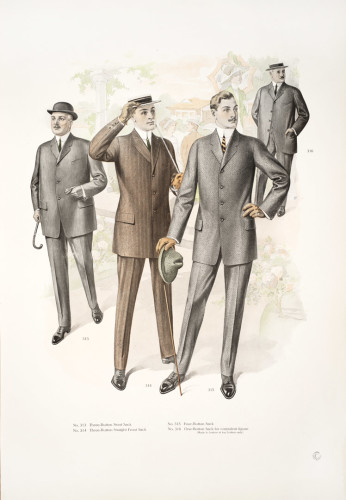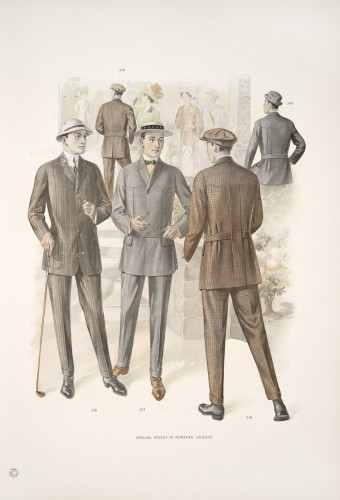The 1910s saw few major changes in the world of men’s fashion. Sure, the Titanic sank, World War One began and ended and the Pulitzer Prize was established. When it came to how men presented themselves to the world though, they were still following many of the traditions and rules from the previous decades, albeit with some subtle revisions.

Among the styles that remained fashionable with the affluent white men of the time were sack and lounge suits – baggy versions of regular suits we know today – and blazers, along with the thick, single-breasted Norfolk jackets, worn when out on a hunt or something similarly rugged and manly. Formal shirts still had stiff, tall collars that didn’t fold down. Rounded collars, nicknamed club collars after their creation at Eton left everyone else to see them as something reserved only for members of that special unattainable club, also continued to be well-liked.
However, after 1910, sack suits dropped the fourth button they had held onto for years and grew larger collars and lapels. This was also the first decade where the neckline moved down to the mid-chest level we know today. Truly, it was an exciting time to be a man.
But wait! You haven’t even heard about the trousers yet.
Before Winston Churchill doggedly dragged us into World War One, the early years of the decade saw the ‘peg-top craze’ sweep through fashion like flu through the offices of Vogue. This delightfully named fad saw men’s trousers balloon out a little in the hips before slimming right down by the ankles. Unfortunately Britain got involved with Europe’s problems, and by the time the war ended, trouser styles sadly straightened out again. Like a bad memory from Duke of Edinburgh, shorter trousers were often worn with gaiters.

Men had three types of shoes they could wear: boots, oxfords and pumps. Labour jobs or heavy walking called for boots, often two-tone with high arches, whereas oxford shoes would be worn for more white-collar business. These type of shoes were similar to the oxford shoes the modern professional wears. Lastly, formal events required pumps, a combination of the oxford shoe and contemporary flats designed for women. All shoes would be tied with silk ribbon.
Now, the well-dressed man of this period couldn’t just throw on a suit and tie like an old-fashioned Justin Timberlake and have done with it. Accessories had to be considered, which usually meant hats. Lots and lots of hats. Silk top hats for upper class formal occasions. Bowler hats for sack and lounge suits. Panama hats (wide-brimmed hats made from straw or a similar material) for travelling. Flat caps for the middle and working class. All had to be perfectly coordinated with the rest of the outfit if you wanted to look your best. As well as hats, gloves were very fashionable and you could tell if a man had made an effort to dress if they matched the neck wear. Cravat ties, neckties and bowties were all popular, with the former worn during the day and the latter vital for formal evening wear. Dark neckties started becoming accepted, and not a moment too soon.
This period may not be hugely associated with great men’s style, but it gave us some of the basic fashion rules that we still adhere to today. And, perhaps most interestingly, it helped set the stage for a far more infamous decade for fashion – the Roaring Twenties.

